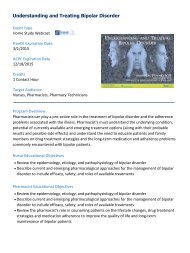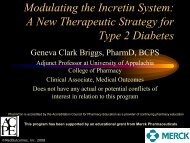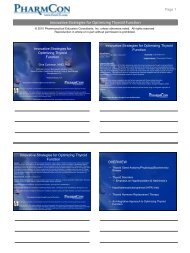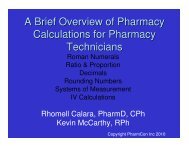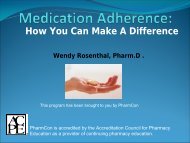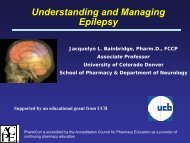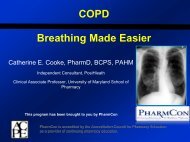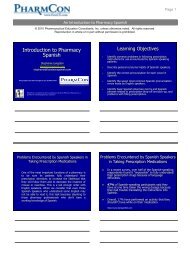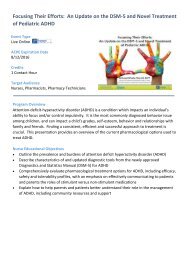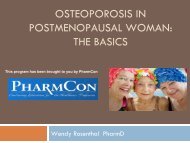Understanding and Treating Acute Coronary Syndrome - FreeCE
Understanding and Treating Acute Coronary Syndrome - FreeCE
Understanding and Treating Acute Coronary Syndrome - FreeCE
- No tags were found...
You also want an ePaper? Increase the reach of your titles
YUMPU automatically turns print PDFs into web optimized ePapers that Google loves.
Page 3<strong>Underst<strong>and</strong>ing</strong> <strong>and</strong> <strong>Treating</strong> <strong>Acute</strong> <strong>Coronary</strong> <strong>Syndrome</strong>© 2010 Pharmaceutical Education Consultants, Inc. unless otherwise noted. All rights reserved.Reproduction in whole or in part without permission is prohibited.Consequences of ACS• Progression to myocardial infarction• <strong>Acute</strong>/chronic LV dysfunction (heart failure)• Arrhythmia• DeathAlgorithm for Initial Assessment <strong>and</strong> Evaluationof the Patient with <strong>Acute</strong> Chest PainChest pain consistent with coronary ischemiaWithin 10 minutes• 12 lead ECG, Establish continuous ECG monitoring• Establish IV with D5W• Aspirin 325 mg (chewed)• IV NTG• Blood for baseline serum cardiac markersTherapeutic/Diagnostic tracking according to 12-lead ECGNot diagnostic /normal ECGECG suggestive of ischemiaT wave inversion orST depressionST segment elevation ornew bundle branch block10ACUTE CORONARY SYNDROMEThrombogenicity of PCIThrombin GenerationNo ST Elevation(-) markers (+) markersST ElevationTissue Factor• Indirect thrombin inhibitors– Unfractionated heparin– LMWH• Direct thrombin inhibitors– Bivalirudin, argatrobanUnstable anginaNSTEMISTEMIMyocardial InfarctionPlatelet Activation• Aspirin• Thienopyridines• Glycoprotein IIb/IIIa inhibitorAdapted from Braunwald, ACC/AHA Practice GuidelinesAdhesion MoleculesVessel Wall InjuryInflammation• High dose statin1112



